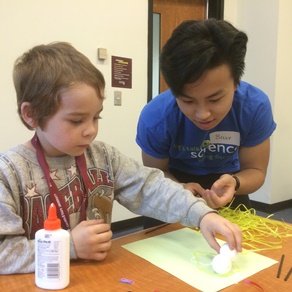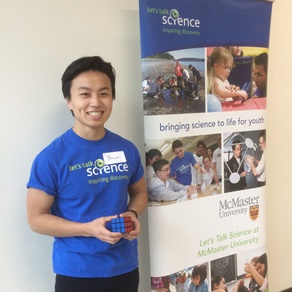Our Stories: Student Volunteer Finds Homemade Slime Can Stretch Minds
To Billy Sun, there’s a formula to turning children on to science. Take borax, mix with white glue, and add food colouring. The result? Homemade slime.
That’s his favourite activity when he volunteers with Let’s Talk Science Outreach at Hamilton area schools in Ontario. “The kids love it because it’s fun,” says Billy, a fourth-year health sciences student at McMaster University.
His own interest in studying science was reinforced by participating as a teenager in Let’s Talk Science’s SET (science, engineering and technology) Challenge — a team-based event that enables students to collaborate, interact with relevant role models and test their abilities against peers.
In high school, Billy competed twice with his school’s team at the SET Challenge hosted by the University of Calgary, near his home at the time. He recalls a couple of captivating experiments, like making a boat from tin foil and seeing the weight it could bear, and using magnets to slow the descent of a falling object.
“We got the chance to apply theory to problems, and saw that what you learned mattered. That was empowering,” says Billy. “Another big thing was the cooperation, working as a team bouncing ideas off each other.”
Today, Billy helps run the Let's Talk Science Challenge for students in Grades 6 to 8 at the Let’s Talk Science Outreach site based at MacMaster University. He also delivers a range of other Let’s Talk Science programs based on science, technology, engineering and math (STEM) for students aged 5 to 11.
The hands-on activities are the key, he says. “The kids get encouraged to try more and learn more. They see a purpose.”
Helping Youth Recognize Science in Every Day Life
Inspiring youth and instilling the notion that science can be cool and creative is why Billy decided to volunteer with Let’s Talk Science Outreach.
|
How it Works Let’s Talk Science Outreach draws on post-secondary student volunteers, some 3,500 from over 40 Canadian universities and colleges where Let’s Talk Science Outreach sites operate. They engage youth in STEM learning experiences in school and community settings. In addition to helping youth build key skills, the activities led by role models like Billy help students to understand and form positive attitudes about STEM’s role in their lives and futures. |
In 2014-15 alone, the national program engaged more than 230,000 children and youth, and 2,300 educators in a wide variety of STEM learning experiences in 375 schools.
It was all made possible thanks to 46,000 hours donated by Outreach volunteers and the generosity of funders that allow the programs and supplies to be offered free of charge.
For students, the appeal of Billy’s slime-making activities is obvious. “They can form shapes, they get to keep it, and it’s exciting,” says Billy. Students may not realize that, in the process, they are also expanding their minds. More than ever, jobs in every field require workers with analytical, critical thinking and problem solving skills — exactly what STEM learning nurtures.
Billy, who has applied to medical school, always loved the logic of science; if A happens, then B follows. “It made sense to me,” he says.
Looking back, Billy sees that even his childhood toys played a part. A Rubik’s Cube was pure problem-solving: “It’s algorithms, math and special orientations.” Eventually, he could solve the cube in 1-2 minutes. He also loved Lego and ignored instructions to instead just make what he wanted, like planes and spaceships. “I liked to experiment and use my imagination.”
Billy’s decision to study science didn’t come from one “eureka” moment, but was part of a process that included his own Let’s Talk Science Challenge experiences in high school.
He says volunteering for Let’s Talk Science Outreach is a chance to pay forward what he gained from those experiences. “It affected me so I wanted to give back. I’m excited about the opportunity to teach things I like, like critical thinking and exploration.”
For anyone considering volunteering, he says, “This is so rewarding. You can make a difference in the way kids see science. And if they continue to be involved, they can really make a difference in this world.”
Donate now to Let’s Talk Science and give the gifts of critical thinking, problem-solving, creativity and collaboration to children and youth across Canada through free educational programs, including Let’s Talk Science Outreach.

